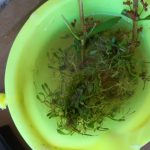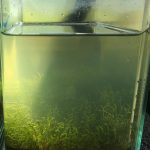
Please identify this small ? Aquatic plant from Lonavala pune : 1 image- 4 mb.
This a new Zealand species Is it even found in India?
A German Aquatic botanist is saying this is Glossostigma diandrum which is the only Glossostigma species found in India.
A feedback from …:
Glossostigma Elatinoides. I recognise it because I grow it. Diandrum has narrower leaves at the top. The top is like the midsection. Here the top of the leaf is larger than the midsection.
But I do not find its distribution in India as per POWO.
While Glossostigma diandrum (L.) Kuntze has distribution in India as per POWO.
I may be wrong (I am not a professional), it’s possible that the Indian variety is not the same as in Australia or the emersed leaf is different to the submersed? It looks a lot like elatinoides to me though which would mean that it is an introduced non-native sample?
Below is a youtube link to what looks to me like Diandrum from India. Diandrum in Australia has an elongated leaf, not fat at the end. But looking at this video again it does somewhat resemble the photo here so I am not sure now.
https://www.youtube.com/watch?v=i11vp7l06Y4
Mysterious Cryptocoryne, Rotula aquatica, Rotala serphylliphyla and Bulbophyllum keiki, Nechamandra alternifolia, aquatic Crinum, Potamegeton so on
The principal distinguishing feature between elatinoides and diandrum is the size of the leaf and spacing on the runner (sorry I can’t provide the scale – the elatinoide tank is only a bit larger than the diandrum one).

Glossostigma Diandrum in Australia:
Photo of what I believe is Glossostigma Diandrum in Australia. I believe this is diandrum (green all the way to the base of the stem) and that cleistanthum turns white at the base of the stem, but it may be the other way around?
.
References:
